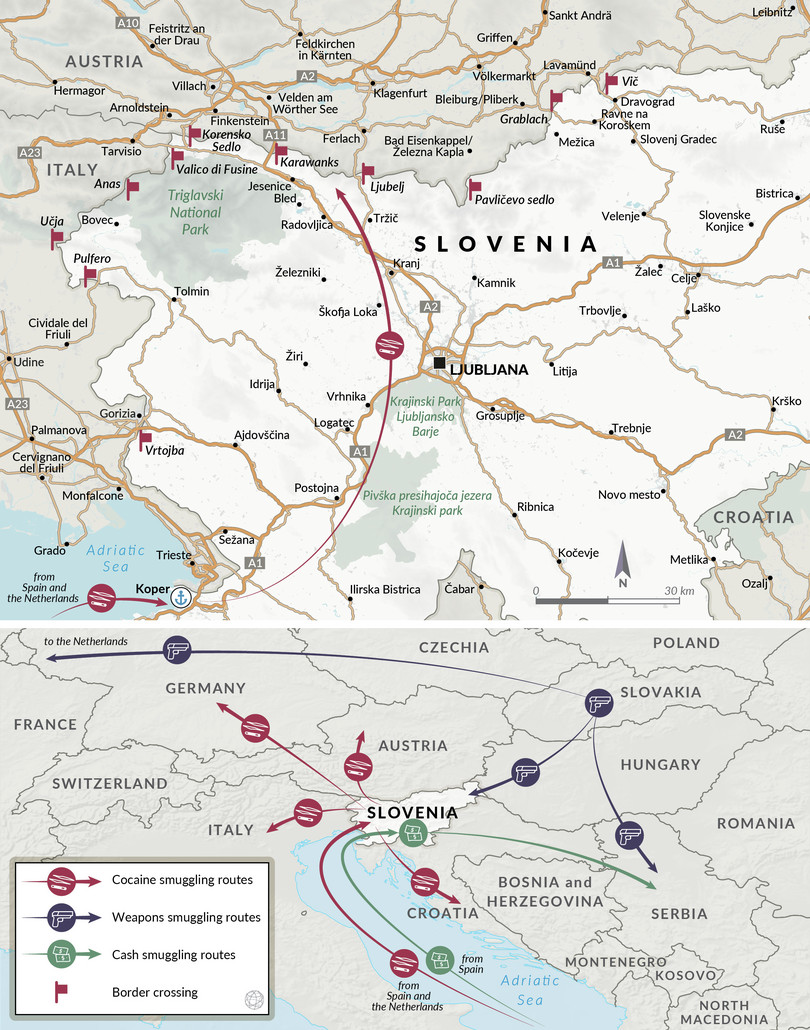Slovenia is a crossroads for criminality between the Balkans and central Europe.
Slovenia is usually off the radar of those analyzing organized crime in central and eastern Europe. However, this seems to make the country an attractive location for criminals from the Balkans as well as to hide out, plan operations and logistics, do business and trans-ship their illicit goods.1
Slovenia is strategically located at the crossroads of central and south-eastern Europe, touching the Alps and the Adriatic Sea. This makes it a useful transit point for goods coming from Adriatic ports – particularly Koper – and for links between the Western Balkans and Italy as well as Austria and Germany. In July 2022, the Ljubljana District Court found eight people guilty of drug trafficking and related criminal acts – including smuggling cocaine from Ecuador to Koper and Rijeka – and sentenced them to a total of 28 years in prison.2 But this is just the latest in a series of cases that reveal the role of criminal groups in Slovenia as mafia middlemen.
Police also report that there are drug storage warehouses in Slovenia.3 The region of Gorenjska, close to the border with Austria, seems to be a hotspot of organized crime.
The Gorenjska region: A criminal hotspot
Gorenjska, the northern Slovenian region bordering Austria, is best known for tourism and alpine vistas, but it is also a hotspot for organized crime. In January 2020, Slovenian police uncovered the biggest synthetic drug lab in Slovenia, seizing 125 kilograms of amphetamines and precursors for producing another 300 kilograms. The members of the criminal group made around €1.3 million in profits.4 Also, the Montenegrin Kavač clan is known to have used the region to store cocaine coming via the port of Koper before distribution to Austria, Germany and Italy.
Drugs, people and weapons are the main goods that are being smuggled via Slovenia and police estimate that there are around ten criminal groups operating in Slovenia.5 Most are connected to criminal groups from the Western Balkans, although some also have links to groups in other EU countries, as well as South America and Africa.6 Slovenians are usually mid-level criminals in the hierarchy of transnational networks. Whereas in the 1990s criminal networks were based on ethnic or regional ties, today the relationships are more fluid and functional. According to one expert, partnerships among criminals operating in the region are based on ‘mutual trust among the members and other [criminal] organizations and the shared goal of gaining quick earnings or acquiring criminal proceeds.’7 The Slovenian branch of various transnational criminal groups reportedly often organize meetings for foreign members who stay several days in Slovenia, since the country is considered a geographically attractive and safe place to meet.

Figure 1 Smuggling routes into and from Slovenia.
Two examples show how Slovenian cells have been part of broader transnational criminal networks. In 2009, several arrests were made in Slovenia as part of Operation Balkan Warrior, in which the US Drug Enforcement Administration together with the Serbian Intelligence Agency and police in Uruguay and Argentina took down Serbian national Darko Šarić, who was known as the ‘narco-king’ of the Balkans. In 2010, police in Slovenia carried out over 30 house searches across the country, arrested 17 people and seized weapons and illicit drugs in a months-long investigation. One of the suspects was Dragan Tošić from Ljubljana, who was known as the leader of the Slovenian section of Šarić’s criminal organization. He allegedly assisted Šarić in trafficking cocaine from Latin America to ports in Europe, particularly in Italy. The prosecution has accused Tošić and 16 other defendants of drug trafficking and participation in an organized criminal group. Remarkably, despite 81 hearings, the court proceedings against the alleged members of the Slovenian cell of Šarić’s organization have not yet concluded.
A second example shows how in Slovenia, once-rigid organized crime group structures are transforming into increasingly flexible forms of temporary and opportunistic cooperation.8 In May 2021, police arrested almost 60 people from Slovenia, Montenegro, Serbia, Bosnia and Herzegovina, North Macedonia and Croatia who were allegedly part of a cell of the Kavač clan (originally from Montenegro) that had been operating in Slovenia since 2018. The most significant contributor to the successful police operation was a former founding member of the cell who turned police informant. The latter seems to have claimed that Serbian and Montenegrin nationals with links to the Kavač clan established the cell in Slovenia and oversaw the flow of drugs and money earned from selling them.9
The indictment states that the cell trafficked drugs from Spain and the Netherlands first to Slovenia and from there to Austria, Germany, Italy and Croatia.10 They communicated via Sky’s encrypted app and referred to each other with aliases. They smuggled at least 534 kilograms of cocaine, 2 000 kilograms of cannabis, 30 liters of amphetamine base, 10 kilograms of heroin, 96 kilograms of hashish and other drugs. They also smuggled weapons from Slovakia to Slovenia, Serbia and the Netherlands. The cash was transported from Spain via Slovenia to Serbia.11 Police estimate that the Slovenian cell’s profit was at least €2 million. It is possible that they had a connection to law enforcement: In November 2021, Slovenian police arrested an employee of the Specialized State Prosecutor’s Office for allegedly disclosing classified information from the criminal investigation against the Kavač clan.12
Criminals in the cell were well-organized and managed the whole chain of illicit activities, including purchase, transport and drug sales, for which special coordinators were in charge. The leader was from Montenegro, while the Slovenian suspects transported drugs and money by opening companies and recruiting new members.
Drugs, weapons and money were mainly transported in cars and trucks in specially modified secret compartments. In trailers, the drugs – primarily large quantities of cannabis and hashish – were hidden in specially-modified trailer compartments or the fridge trailers. Couriers picked up the cars and trucks with the cargo, for example in Spain and the Netherlands, and drove them to Slovenia, where the drugs and weapons were stored in warehouses.
Major law enforcement operations in Slovenia, 2015–2022

The latest law enforcement operations in Slovenia show that this country is far from the perceived image of being away from the interest of international drug traffickers. Its geographical position, between the Balkans and central Europe, makes this country especially favorable as a crossroads for trafficking of narcotics.
Trafficking is also facilitated by the port and land-developed infrastructure in the country, and its shared past with the former Yugoslavia make it a familiar destination for Balkans criminal groups. Law enforcement agencies should as a result pay more attention to these links.
Notes
-
Slovenia among the safest countries for travellers, Government Communication Office, 18 November 2019, https://www.gov.si/en/news/slovenia-among-the-safest-countries-for-travellers/. ↩
-
STA, Gang Jailed for 28 Years for Trafficking Heroin, Cocaine, MDMA, Marijuana, & Amphetamines, Total Slovenia News, 21 July 2022, https://www.total-slovenia-news.com/news/10317-gang-jailed-for-28-years-for-trafficking-heroin-cocaine-mdma-marijuana-amphetamines. ↩
-
Interview with Petra Grah Lazar from the Slovenian National Bureau of Investigation, 12 April 2022. Slovenian members of the Kavač clan are suspected of having had warehouses in Naklo, Koper and Divaca. ↩
-
Drug Bust Finds Largest Ever Synthetic Drug Lab in Slovenia, Total Slovenia News, 31 January 2021, https://www.total-slovenia-news.com/news/5514-drug-bust-finds-largest-ever-synthetic-drug-lab-in-slovenia. ↩
-
Interview with a Slovenian Criminal Police Directorate representative in Ljubljana, April 2022. ↩
-
Damijana Žist, Damjan Apollonio: Letni dobiček kriminalnih združb dosega 110 milijard evrov, Večer, 8 January 2022, https://www.vecer.com/kronika/intervju-damjan-apollonio-letni-dobicek-kriminalnih-zdruzb-dosega-110-milijard-evrov-10265764. ↩
-
Damijana Žišt, Matjaž Jerkič: Najhujša kršitev kodeksa med kriminalci je izdaja, Večer, 12 June 2021, https://www.vecer.com/kronika/najhujsa-krsitev-kodeksa-med-kriminalnimi-zdruzbami-je-izdaja-policiji-10245091. ↩
-
Damijana Žišt, Damjan Apollonio: Letni dobiček kriminalnih združb dosega 110 milijard evrov, Večer, 8 January 2022, https://www.vecer.com/kronika/intervju-damjan-apollonio-letni-dobicek-kriminalnih-zdruzb-dosega-110-milijard-evrov-10265764. ↩
-
Tamara Sekulović, Ko so »Kavačani« iz Slovenije i kako so nastali:Švercovali kokain, a u Beograd donjeli oružje i milijone, Blic, 27 May 2021, https://mondo.rs/Info/Crna-hronika/a1475939/kavacki-klan-uhapsen-u-sloveniji.html. ↩
-
Damijana Žišt, Slovenija je ena najvarnejših držav v Evropi, Petra Grah Lazar, Ljubljana, 12 April 2022 (terenski zapis). Interview with Petra Grah Lazar from National Bureau of Investigation, Ljubljana, 12 April 2022. ↩
-
Ibid. ↩
-
Damijana Žišt, Damjan Apollonio: Letni dobiček kriminalnih združb dosega 110 milijard evrov, Večer, 8 January 2022, https://www.vecer.com/kronika/intervju-damjan-apollonio-letni-dobicek-kriminalnih-zdruzb-dosega-110-milijard-evrov-10265764. ↩
